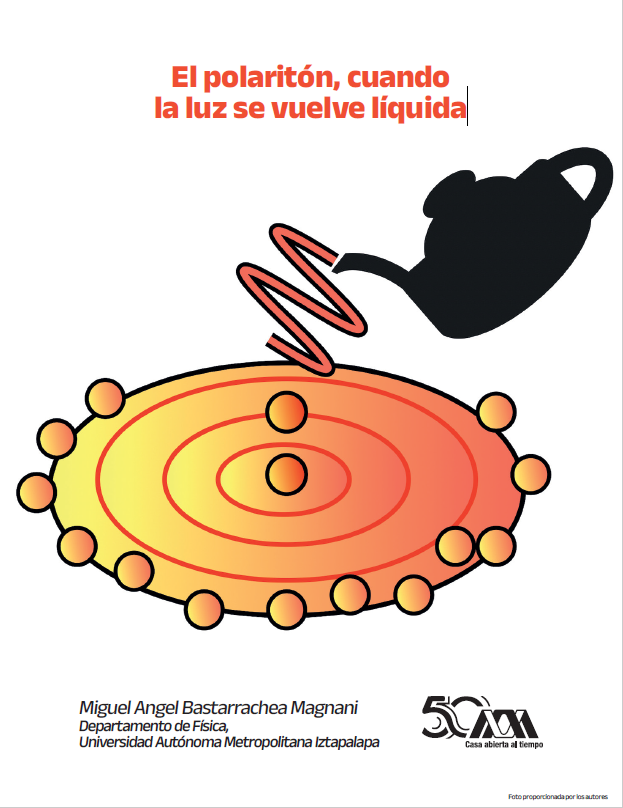El polaritón, cuando la luz se vuelve líquida
Abstract
This work explains the concept of polariton, a quantum quasiparticle that results from the strong coupling between light and matter and that, thanks to its hybrid character, has become a tool not only for the understanding of fundamental phenomena in quantum, condensed matter, and atomic physics but also for the design of new quantum technologies. In particular, the case of exciton-polaritons in semiconductor microcavities is reviewed, which by virtue of the strong interactions that can be generated between them and that result in novel nonlinear optical effects, their out-of-equilibrium character, their ability to form quantum macroscopic states as condensates and superfluids, and its potential to integrate new light-matter quasiparticles have earned the name of quantum fluids of light.
Downloads
References
Bastarrachea-Magnani, M. A., Camacho- Guardian, A. y Bruun, G. M., Attractive and Repulsive Exciton-Polariton Interactions Mediated by an Electron Gas, Phys. Rev. Lett. 126, pp. 127405, 2021. https://doi.org/10.1103/PhysRevLett. 126.127405
Bloch, J, Carusotto, I., Wouters, M., Non-equilibrium Bose–Einstein condensation in photonic systems, Nat. Rev. Phys. 4, pp. 470-488, 2022. https://www.nature. com/articles/s42254-022-00464-0
Carusotto, I y Ciuti, C., Quantum fluids of light, Rev. Mod. Phys. 85, pp. 299-366, 2013. https://doi.org/10.1103/RevModPhys. 85.299
Geim, A. K. y Grigorieva, I. V., Van der Waals heterostructures, Nature 499, pp. 419–425, 2013. https://www.nature.com/ articles/nature12385
Hopfield, J. J., Theory of the Contribution of Excitons to the Complex Dielectric Constant of Crystals, Phys. Rev. 112, pp. 1555-1567, 1958. https://doi.org/10.1103/ PhysRev.112.1555
Gómez García, E. y Barberis Blostein, P. Iniciativa Mexicana en Tecnologías Cuánticas. Unidad de Publicaciones y Difusión del Instituto de Investigaciones en Matemáticas Aplicadas y en Sistemas, UNAM, Ciudad de México, 2023. https:// www.dicu.com.mx/imtc
Kavokin, A., Liew, T. C. H., Schneider, C., Lagoudakis, P. G., Klembt, S., Hoefling, S., Polariton condensates for classical and quantum computing. Nat. Rev. Phys. 4, pp. 435-451, 2022. https://www.nature.com/ articles/nature12385
Luo, J., Close the gap in the US CHIPS and Science law, Nature 610, 34 (2022). https:// doi.org/10.1038/d41586-022-03122-8
Riedel, M., Kovacs, M., Zoller, P., Mlynek, J. y Calarco, T., Europe's Quantum Flagship initiative, Quantum Sci. Tech. 4 020501, 2019. https://iopscience.iop.org/ article/10.1088/2058-9565/ab042d
Lecturas recomendadas:
Combescot, M. y Shiau, S.-Y., Excitons and Cooper Pairs. Two Composite Bosons in Many-Body Physics, Oxford University Press, Oxford, 2016.
Haroche, S. y Raimond, J-M., Exploring the Quantum: Atoms, Cavities and Photons, Oxford University Press, 2006.
Kavokin, A. V., Baumberg, J. J., Malpuech, G., y Laussy, F. P., Microcavities, Series on Semiconductor Science and Technology, Oxford University Press, Oxford, 2017.
Pethick, C. J. y Smith, H. Bose-Einstein Condensation in Dilute Gases, Cambridge University Press, Cambridge, 2008.
Sakurai, J. J., y Napolitano, J., Modern Quantum Mechanics, Addison-Wesley, San Francisco, 2011.






